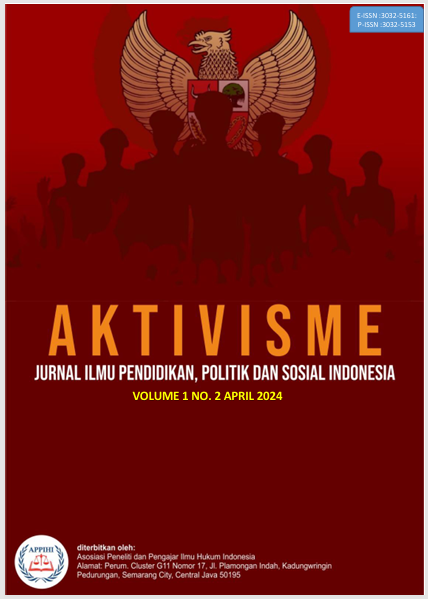Analisis Penggunaan Batik Secara Efektif Pada Implementasi Produk Lokal
Perspektif Keberlanjutan Untuk Mendorong Ekonomi Warga Setempat
DOI:
https://doi.org/10.62383/aktivisme.v1i2.174Keywords:
Batik, UNESCO, UCCNAbstract
Preserving local culture, especially batik, is an important aspect of sustainable development in Indonesia. This research aims to see how people in Indonesia realize how important it is to preserve batik culture, especially for the community to encourage local products. This research uses a qualitative descriptive method with primary data in the form of observations and interviews and secondary data in the form of literature studies, including books, journals and other internet sources. The research results found that efforts to preserve batik continue, driven by the government's commitment as a member of the UNESCO Creative Cities Network (UCCN). Through the implementation of the Sustainable Development Goals (SDGs), creative cities like Pekalongan can become models of sustainable development by combining aspects of creativity, arts education and cultural heritage preservation. In this way, local culture is not only a national identity, but also an instrument for achieving overall sustainable development goals.
Downloads
References
Anis, M., & Indriyagandhi, A. H. (2020). Analisis Faktor Pendorong Minat Masyarakat terhadap Pemakaian Batik dalam Upaya Pelestarian Batik Pati. IENACO (Industrial Engineering National Conference) 8 2020.
Azwar, S. (2014). Metode Penelitian, Yogyakarta: Pustaka Pelajar, 2012. Reliabilitas Dan Validitas Edisi, 4.
Kuncoro, M. (2013). Metode Riset untuk Bisnis & Ekonomi Edisi 4. Jakarta: Penerbit Erlangga.
Malik, A., Retno, R., & Ayu, A. (2016). Pengaruh komposisi malam tawon pada pembuatan batik klowong terhadap kualitas hasil pembatikan. Teknoin, 22(6).
Moleong, L. J. (2017). Metode penelitian kualitatif, Bandung: PT. Remaja Rosda Karya, 17.
Punpeng, G. (2020). Three Pillars of a Sustainable Creative City in ASEAN. Journal of Urban Culture Research, 125.
Riandova, I. A., Basyir, M., Matin, H. M., & Ashadama, A. (2022). Hubungan Penggunaan Batik Pada Busana Pesta Terhadap Kecintaan Kepada Produk Lokal. Jurnal Ilmu Budaya, 10(2), 147-153.
UNCTAD. (2008). The Challenge of Assessing the Creative Economy: towards Informed Policy-making. In United Nations. http://unctad.org/en/Docs/ditc20082cer_en.pdf%5Cnhttp://www.oecd.org/dataoecd /35/56/2101733.pdf%5Cnhttp://unctad.org/en/pages/PublicationWebflyer.aspx?pu blicationid=1595%5Cnhttp://www.isc.hbs.edu/Innov_9211.pdf
UNESCO. (2004). Mission Statement (Vol. 94, Issue 1). https://doi.org/10.4324/9780429501074-25
Zinkernagel, R., Evans, J., & Neij, L. (2018). Applying the SDGs to cities: business as usual or a new dawn?. Sustainability, 10(9), 3201.
Downloads
Published
How to Cite
Issue
Section
License
Copyright (c) 2024 Aktivisme: Jurnal Ilmu Pendidikan, Politik dan Sosial Indonesia

This work is licensed under a Creative Commons Attribution-ShareAlike 4.0 International License.





